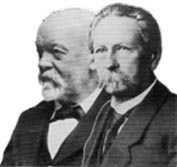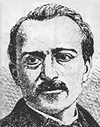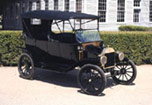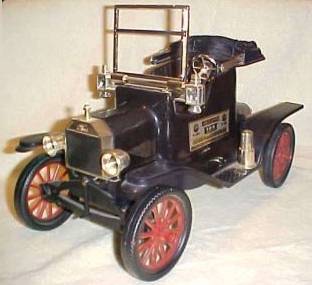History of Motor Vehicles
When was the first car built? Daimler and Benz are traditionally credited with building the first cars in 1886, but the French claim it was first built in 1884 by Delamare-Deboutteville. Still others claim it was built in 1860. It all depends on your definition of a car.
Contrary to popular belief, Henry Ford did not invent the car. He wasn't even close. What Ford did was perfect the assembly line technique, well after the turn of the century. This allowed him to lower the cost of the car drastically, bringing a rich man's plaything within reach of the masses, thereby changing Western society. Reason enough to be famous.
In 1860 a Frenchman, Edouard Delamare-Debouteville, did some experiments and filed some patents for a self-propelled car. In 1884 France built the worl d's first car. However the first self-propelled car existed long before 1884.
d's first car. However the first self-propelled car existed long before 1884.
Steam-powered stage coaches were in regular service between many towns in Britain from 1820 to 1840. They were built by such men as Goldsworthy Gurney, Walter Hancock, Ogle & Summers, Squire & Macerone, John Scott Russell and others.
Charles Dietz and his sons ran steam-driven road tractors hauling passenger carriages on routes around Paris and Bordeaux prior to 1850. And in America, steam coaches were built in the 1860 to '80 period by Harrison Dyer of Boston, Joseph Dixon of Lynn, Mass., Rufus Porter of Hartford, Conn., and William T. James of New York City.
Amedee Bollee Sr. was the most remarkable of the steam-car pioneers. Heir to a bell foundry at Le Mans, he added mechanical workshops and built a series of advanced-design vehicles from 1873 to 1883. There was nothing particularly new or refined in his steam power systems, but his sense of vehicle architecture was superb. La Mancelle, built in 1878, had a front-mounted engine, shaft drive to the differential, chain drive to the rear wheels, steering wheel on a vertical shaft and driver's seat behind the engine. The boiler was carried behind the passenger compartment. Bollee built a series of steam carriages with romantic names like Rapide and L'Obeissante (the Obedient One). His sons, Amedee Jr. and Leon, both became makers of gasoline-powered cars. Amedee Sr. also invented an independent front-wheel suspension system with upper and lower transverse leaf springs in 1878.
Use of steam power for road vehicles can be traced back to 1769, when a French artillery engineer, Nicolas Joseph Cugnot, constructed a three-wheeled military tractor at the Paris Arsenal. It ran at a speed of 2 1/2 mph, but it was nearly uncontrollable and crashed into a stone wall during a demonstration.
Was this the birth of the car? It depends. The Cugnot vehicle can be regarded as the first car in the world, if the definition is broad enough. How should it be defined? By fuel, type of engine, drive system, seating capacity, speed or what?
When Daimler-Benz (makers of Mercedes-Benz cars) says that the car was invented in 1886 by Karl Benz and Gottlieb Daimler, it's basing its claim on its own  definition: a light carriage for personal transport with three or four wheels, powered by a liquid-fueled internal combustion engine. In doing so, the company ignores Daimler's gas-powered motorcycle of 1885
definition: a light carriage for personal transport with three or four wheels, powered by a liquid-fueled internal combustion engine. In doing so, the company ignores Daimler's gas-powered motorcycle of 1885
But even by that definition, the French have a prior claim: Belgian-born Jean Joseph Etienne Lenoir, who settled in Paris and became a naturalized French citizen, invented his gas engine in 1858 and patented it in 1860. He used electric spark ignition, but the engine ran on stove gas and had no compression. It was shown to the press in a three-wheeled cart in 1860. A liquid-fuel version, with a primitive carburetor, was built in 1862 and installed in a three-wheeled wagon early in 1863. It is on record that it successfully covered the 18 kilometres from Paris to Joinville-le-Pont and back, securing its place in history as the first spark-ignition petroleum-fuel car to demonstrate its roadworthiness.
But Lenoir did not continue his work on cars. So we (and Daimler-Benz) can make the Lenoir claim void by narrowing the definition further: It doesn't count as a car if you gave up. You must persevere, and your experiments must lead to actual car production. That's what Karl Benz and Gottlieb Daimler did. Or did they?
From the experimental cars of Daimler and Benz it was indeed a short step to industrial production -- but not in Germany. Daimler-Benz concedes that the first car manufacturers in the world were French -- Panhard & Levassor in 1889, followed by Peugeot in 1891. Since both were buying their engines from Daimler when production began, vital participation by the motor makers of Germany is implicit. At that time, Daimler was more interested in royalties and licensing fees for his engines than he was in actually building cars.
The French companies made each new car a little bit different from its predecessor for years. The first true production model was the Benz Velo of 1894. Benz built 134 cars to the exact same specification during 1895.
In the meantime, the French had invented motor racing: The Parisian daily newspaper Le Petit Journal sponsored a run from Paris. to Rouen in 1894. The following year, a group of wealthy enthusiasts founded the car Club de France, the first of its kind.
When Henry Ford refused to pay royalties, a famous court suit followed. During the long trial, the owners of Selden's patent were finally forced to build a vehicle in 1904. Essential details in Selden's patents had been left deliberately vague, and the car built in 1904 had much benefit from then-current technology. Despite all these loopholes, the "1877" Selden barely ran. The patent was finally shot down in 1911.
Those are uncontested facts. The trouble is that now the French want the world to believe it was Edouard Delamare-Deboutteville who invented the car, in 1884.
Deboutteville was 22 years old when he went to work in his brother's textile plant just outside Rouen. A year later, in 1879, he invented a universal machine capable of cutting, milling, drilling and turning. He became interested in the internal combustion engine primarily as a source of power to run the machinery in factories, and secondarily for propelling road vehicles. He was aware of the patents of Beau de Rochas and Lenoir, and also knew of Otto's patent.
His first engine was a single-cylinder four-stroke unit, built early in 1883. It ran on stove gas, but Deboutteville had also created a carburetor for running on liquid (petroleum) fuels. The outstanding things about his engine were:
* Coil-and-battery ignition, with a sparkplug.
* Mechanically operated overhead intake and exhaust valves.
* High compression ratio.
This engine was put in a three-wheeled vehicle that was destroyed in an accident. Undaunted, Deboutteville built a four-wheeled car with a two-cylinder engine. This design figures in the 1884 patent. The vehicle was a modified horse-drawn wagon, but the new engine was noteworthy for its:
* Pistons with rings
* Provision for air- or water-heating of the carburetor
* Air- or water-cooling of the cylinders
* Speed control on the intake manifold
* Exhaust muffler
* Progressive clutch
It is certain that the car was built, but the evidence that it ever ran is weak. You'll look in vain for any mention of a test drive in local newspapers. Deboutteville's patent went unnoticed. It was never exploited at all.
A great pity, for Deboutteville's proposed car was extremely well thought out. He had solutions to all the basic problems, but he had to give up his experiments to concentrate on making a living. Instead of developing the car, he removed its engine and put it to use in the factory. He became a manufacturer of industrial engines, but had nothing more to do with cars.
Both Daimler and Benz could have gained by reading the 1884 patent, for their first vehicles were very primitive in several regards. Daimler's engine from 1885 was a vertical single-cylinder of 462-cc displacement, delivering 1.1 hp at 650 rpm. It had a suction-operated intake valve and hot-tube ignition. It had an evaporative "surface" carburetor, and the speed control was a butterfly valve mounted on the exhaust pipe. He did not design a car for it, but installed it in a horse carriage with a centrally pivoted front axle. And it did not run in 1886. The first test drive took place on Mar. 4, 1887.
Karl Benz spent many years developing the two-stroke engine before turning his attention to the four-stroke cycle in 1885. He put a slide valve on the intake port and fired its sparkplug from a high-tension coil. The mixture was produced in a surface carburetor, and he put a speed governor on the intake side. The single-cylinder Benz engine had 954-cc displacement and delivered 0.67 hp at 250 rpm.
The "car" Benz designed around the engine was a light three-wheeler with belt drive, which first ran on the streets of Mannheim in June 1886. Benz did not build a four-wheeled car until 1891. It was only after seeing the success of Peugeot and Panhard & Levassor that Daimler and his assistant, Wilhelm Maybach, began to think in terms of complete cars rather than just engines.
Was the car invented in France or Germany? The argument may never be resolved to the satisfaction of both sides. One thing to bear in mind is that the car is not one invention but a mechanical creation composed of hundreds, if not thousands, of inventions. In truth, we are still inventing the car, for the car is an ever-changing assembly of ideas, systems and parts. In the past 100 years, the French contribution to its advance has been as significant as that of the Germans.
First Century of American Automobiles
The first "car" built in America was a horse buggy with a 4-hp, single-cylinder engine, assembled by Charles and Frank Duryea in 1892-93. Their second car won America's first auto race, a 50- mile, nine-hour marathon from Chicago to Evanston, Ill., on Thanksgiving Day, 1895.
Ransom Eli Olds built a three-wheeled steam car in 1891 and a gasoline buggy in 1897. By the turn of the century he was mass producing his curved Dash Oldsmobile, selling 2100 of them in 1902 and 5000 a year by 1904, when he left Oldsmobile to found the REO Motor Car Co. Henry Ford perfected the assembly line, but Olds had introduced mass production and popularly-priced cars to America.
The first practical, factory-produced automobiles were little more than motorized horse carriages. A tiny one-cylinder motor under the seat drove through a chain, and you steered with a "tiller," like a coaster wagon. Nothing to it. It was enough to be getting around a little faster than a horse could take you. And the car didn't get tired after a few hours.
Within a few years, automobiles had taken on the general configuration we know today. That is, a multi-cylinder engine in front, clutch and transmission under the front floor, shaft drive to a live rear axle, leaf springs on all wheels, foot-operated brakes, steering by wheel and gear linkages, and pneumatic tires. Advanced developments that came in this early period before World War I included electric starters, shock absorbers, four-wheel brakes, all-steel bodies, helical gears, pressure lubrication in engines, automatic spark advance, demountable rims and fabric cord tires.
Despite these early advances, there were some tough unsolved problems that made "automobiling" a definite challenge. Tires wore out fast and blew out at every opportunity. Gasoline was more like kerosene, and oil was like molasses. Cold-weather driving was hardly practical. Alloy steels weren't very strong, so axles and springs frequently broke in deep ruts. The electric starter made it possible for women to drive -- but they still had to cope with the balky transmission and heavy clutch. Electric cars were recommended for ladies.
Engine maintenance required constant attention. Valves needed grinding and rings and bearings needed replacement every few months. Sparkplugs and ignition points were iffy, even when new. Cylinder heads had to be removed to dig carbon out of the chambers, and oil sludge could be scooped out of crankcases by the handful. Actually, automobiles were rich men's playthings in those early years.
Henry Ford's famous Model T changed all th is in the period around WWI and the early 1920s. Here was a car that combined most of the worst mechanical faults of its contemporaries -- and yet it was a milestone development of automotive history. The secret: The first successful use of assembly line mass production. Ford popped out millions of the things over a 20-year period, with only minor changes in design. This not only brought the price down to where anybody could afford one, but it filled the junkyards with an endless supply of dirt-cheap interchangeable parts that you could bolt together to keep your T on the road indefinitely. Crude as it was, the Ford Model T literally put America on wheels.
is in the period around WWI and the early 1920s. Here was a car that combined most of the worst mechanical faults of its contemporaries -- and yet it was a milestone development of automotive history. The secret: The first successful use of assembly line mass production. Ford popped out millions of the things over a 20-year period, with only minor changes in design. This not only brought the price down to where anybody could afford one, but it filled the junkyards with an endless supply of dirt-cheap interchangeable parts that you could bolt together to keep your T on the road indefinitely. Crude as it was, the Ford Model T literally put America on wheels.
The decade of the 1920s was a time of refining basic principles. Or, honing the crude ingredients into something resembling easy, comfortable dignified transportation. For instance, the introduction of the "ethyl" lead additive for gasoline in 1923: This allowed a two-point jump in compression ratios overnight, which helped both performance and fuel economy. The '20s also saw the switch to closed sedan bodies for family cars, sometimes even with the luxury of a heater. A 6- or 8-cylinder engine rested on rubber mounts to reduce vibration, with hydraulic shock absorbers and low-pressure "balloon" tires to cushion the road. Other refinements that occurred in the '20s included such things as automatic chokes, easy-shifting synchromesh transmissions, automatic chassis lubrication, power-operated windshield wipers, vacuum-assisted clutches and even the first crude experiments with power steering.
Ride improvements
Engineers remember the 1930s mainly for tremendous improvements in the ride quality of American cars. Two major breakthroughs brought it about: Engines were moved forward between the front wheels. This not only gave more passenger space, but the engine mass far forward smoothed out the pitch frequency. The car floated instead of bouncing. Another trick was independent front suspension on coil springs. Remember GM's "Knee Action"? Getting rid of the heavy beam front axle not only reduced the oscillating mass of the front wheels for better ride, but eliminated shimmy and feedback in the steering. Cars had an entirely different feel overnight.
These changes also brought a revolution in body styling. Shortening the hood and moving the passengers forward allowed modern "fastback" lines, with grilled radiators and skirted fenders. Chrysler had a disastrous experience with aerodynamics in 1934 -- its Airflow model just didn't sell -- but cars like the 1936 Lincoln Zephyr set styling patterns for years to come.
The modern-car image got another boost in 1939, when Oldsmobile introduced the first fully automatic transmission -- a fluid coupling tied to a self-shifting, four-speed planetary gearbox. All you had to do was put the shift lever in DRIVE, step on the gas and go. The American family car was never the same after that. After WWII, automatic transmission development mushroomed in all directions -- torque converters two-speed gearboxes, geared turbines. By the mid-1950s, automatics were ordered on the majority of all family cars.
Horsepower race
The '50s also will be remembered for the horsepower race. After Olds and Cadillac introduced the modem shortstroke overhead-valve V8 engine in the late '40s, the whole industry seemed to go crazy for performance, power, and luxury. Family cars were considered social prestige symbols in those days, so you needed a muscular engine to heft around all that chrome and sheet metal. Within 10 years, the typical car weighed over 2 tons and packed 300 hp in a big-inch V8 that gave only 10 or 12 mpg. The package also included an automatic transmission, power steering and power brakes. Not bad cars -- but big and gaudy.
Auto enthusiasts like to remember the 1960s for 400-hp factory "muscle cars" and unrestrained industry wooing of a lucrative new youth/performance market. And there were some wild developments here. But it was also the decade when family automobiles were upgraded with such luxuries as air conditioning, power seats, power windows, individual bucket seats, automatic headlight dimmers and fold-down seats in station wagons.
Ride smoothness and silence were helped by the general adoption of coil spring suspension on all wheels, ultra-low tire pressures and isolating the body on a flexible perimeter frame that actually acted as a crude spring to soak up road harshness.
History of the UK car industry
For the last hundred years British car-making capitalists have shown two distinguishing features – greed and stupidity. The motor industry, together with passenger air transport and the computer, is probably the defining technology of the twentieth century. A hundred years ago the engineering capitalists who had the technological know-how to move into this vast potential new market were not that bothered. They were doing very nicely out of arms contracts with the government. Then as now imperialism and militarism crowds out innovation.
In any case they lacked the vision of the likes of Henry Ford (a thoroughly nasty piece of work) who foresaw homes with a car on every drive, and laid plans for mass production accordingly. As early as 1913 his US plant was churning out 200,000 cars a year while the biggest UK producer, Wolseley, was only making 3,000. British motor manufacturers saw themselves as producing a plaything for the rich while Ford wanted to sell the Model T to every well-paid worker and small farmer in the USA.
production accordingly. As early as 1913 his US plant was churning out 200,000 cars a year while the biggest UK producer, Wolseley, was only making 3,000. British motor manufacturers saw themselves as producing a plaything for the rich while Ford wanted to sell the Model T to every well-paid worker and small farmer in the USA.
Ford realised that, to make his cars affordable, he had to produce them on a mass scale. He introduced techniques of mass production (now known as ‘Fordism’) and made sure his car plants were planned to the last detail. Everything possible was done in-house: he didn’t want any nasty surprises. The trouble, for his imitators in Britain, was that this would involve a lot of costly investment. They preferred to rely on outside suppliers for components. Morris, which emerged as the biggest domestic producer, was family owned and did not even raise finance by launching its shares on the Stock Exchange till the mid-1930s. The families that owned these car firms saw them as tickets to buy town and country homes and places in London ‘society’ – rather than factories to be invested in for the future. Their preference for dividends over investment promoted a short term outlook within the firm. Morris did not appoint an experimental engineer till 1949, and spent just 1% of turnover on research.
Mass Production
For all that, Britain emerged from the Second World War as the second biggest car producer and the biggest exporter in the world. Let’s see how management squandered that position.
What were the scale economies embraced by the US mass producers and balked at by the smaller UK companies? By the 1970s it is reckoned that engine blocks could be produced efficiently only at levels of a million a year. The pressing out of body panels required huge capital investment and two million a year needed to be made to be producing at least cost. By 1970 the minimum efficient size of a car plant was reckoned to be two million vehicles. The combined UK producers, by now called British Leyland, were producing 200,000 – 250,000 cars a year.
The economics of mass production meant that producing below capacity produced massive cost penalties in terms of expensive plant lying around unused.
By 1969 Ford had invested three times as much fixed capital behind the elbow of each of their car workers as British Leyland. Not surprisingly productivity in Ford was three times the BL level.
It wasn’t just the Americans. In 1965 the ‘average’ German car worker made 6.4 cars a year compared with 5.8 in Britain. In 1970 he made 7.5 and in 1976 he made 7.9. British car-making productivity actually fell over that period.
Sup-optimal levels of production increased costs – which hurt sales – which produced below capacity output in the factory – which hurt sales some more. And all the while the boss class made merry. British Leyland (now MG Rover) made £75 million between 1968 and 1975. £70 million was syphoned straight out by the shareholders. The bosses’ hands in the till is as British as roast beef and Yorkshire pudding
The decline of UK car manufacturing became evident after 1960. Critics blame the panic amalgamations in the 1960s for the decline. Actually they were a response to a rot that had already set in. Austin, Morris and all the UK producers collapsed together into a heap called, for a time, the British Motor Corporation. The 1964-70 Labour government encouraged amalgamation to produce a ‘national champion’ big enough to take on the global competition. It was already too late.
The 1968 merger left 48 factories scattered over the country. No real move to mass production was initiated. Rationalisation only reduced the number of engines from nine to three. Even marketing remained divided with separate ‘Austin’ and ‘Morris’ dealers selling an identical Mini, apart from the badge.
In 1975 British Leyland collapsed and was promptly bailed out by the Labour government. So what’s Blair’s problem?
Leyland was privatised by Thatcher in 1988. They managed to get rid of it to British Aerospace by writing off £150 million. In the 1980s BL, now called MG Rover, began to build links with Honda. It is a measure of decline that the British motor industry was now dependent for new models and cutting edge technology on Japanese industry, which had been a smoking ruin in 1945.
In the 1960s Lord Stokes of British Leyland, stated, ‘We don’t make motor cars, we make money.’ The firm he headed now makes neither.

